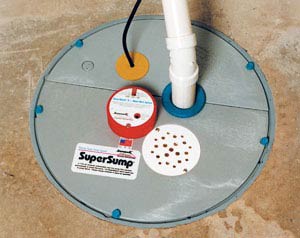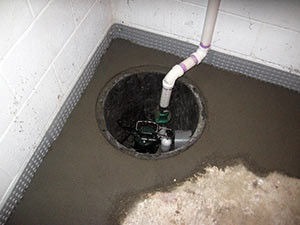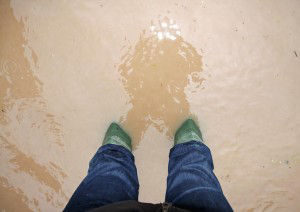Winter may technically be over, but the threat of water damage is ever-present. Many people think that once the snow melts away, the threat of basement flooding is gone. This, however, could not be further from the truth. Heavy rains throughout the Chicago area prove that often. 
Your sump pump is your last line of defense against flooding. If your sump pump fails during a storm, water damage could be in your future. In fact, sump pump overflow is one of the leading causes of basement flooding in the Chicago area.
According to the Insurance Information Institute (III), water damage, including sump pump overflow, accounts for 26% of all residential insurance claims and the average water damage claim is $5,531. Just a few inches of water can cause thousands of dollars in damage if not rectified quickly by a professional water damage restoration company.
Causes of Sump Pump Overflow
- The number one reason behind sump pump overflow is an electrical outage. If it is storming and you lose power, your sump pump also loses power, which can spell disaster. You can combat this by having a battery backup system in place. This ensures your sump pump works when you need it most.
- As the ground thaws after this seemingly endless winter, the soil becomes overly saturated with water. This, coupled with heavy rains, means one thing: pooling water. Once water begins to collect, it finds the easiest path to flow, which is typically along your home’s foundation, down into your basement, and into your sump pump basin. As groundwater levels rise, it is diverted to the sump pit. When this water reaches the “critical level,” the sump pump is activated and water is diverted away from the home. When a sump pump fails, this water continues to rise until it reaches the basement floor level, flooding your home.
- Another common problem with sump pumps is neglect. When was the last time you tested your sump pump? Does it work? It is a good idea to test your system AT LEAST annually. So put it on your spring cleaning checklist, because April showers can bring more than just May flowers. They can also lead to water damage.
 Additional causes behind sump pump overflow include:
Additional causes behind sump pump overflow include:
- A Bad Discharge Pipe: Your discharge pipe is supposed to take water safely away from your house. If it fails to do so, that water will quickly find its way back into your basement.
- Stuck Float Valve: If the float valve is stuck, your sump pump will not work properly.
- Failed Check Valve: If the check valve is clogged, your sump pump will not work properly as well.
- Unplugged: If your sump pump is accidentally unplugged, it cannot do its job.
Of course, a big cause of sump pump overflow could simply be an older unit. Most sump pumps are built to last for about 10 to 12 years. If yours is older and keeps failing, you may be in need of a replacement.
What to Do When Your Sump Pump Overflows
If you find yourself in the uncomfortable position of having a semi-flooded or completely flooded basement due to a sump pump malfunction, do not panic. Instead, take a few steps to fix what you can before contacting a professional such as ServiceMaster of Lincoln Park to talk about water flooding removal.
First, though, make sure that you are safe. In the event that your basement is completely flooded, do not wade into the water. This can be dangerous due to water touching electric outlets and power sources. However, if you only have a bit of flooding, you can follow some easy instructions to improve the situation:
- Make sure that your sump pump is plugged in and turned on. Plenty of homeowners do not realize their basic issue is a sump pump without any power source.
- Pull the top off the sump pump and pull the float switch up towards you. This can sometimes cause the motor to begin running again. You may want to first unplug the sump pump unit and re-plug it in, just to see if you can get a restart.
- Look for cracks or water seepage in your sump pump unit. Notice something amiss? Contact a sump pump repair person to evaluate the situation.
- Clean out any dirt in the weep hole, which is a small opening between the basic sump pump unit and the check valve. You will have to be very careful, so if you feel uncomfortable doing this yourself, hire a technician to perform the cleaning instead.
- Examine the discharge line for traces of built-up debris. The discharge line can easily become clogged, making it impossible for the unit to effectively pump water outside.
Things to Check If Your Sump Pump Is Not Draining
The goal of a sump pump is to drain water away from your home. If yours is not doing its job, you may want to visually examine several of the key elements.
The first is the interior of the tank. Use a flashlight to see if you can spot anything that looks like a crack, or an area that seems to have a heavy concentration of dirt, rust or some other unwanted material.
Next, find out if your motor is running by turning the sump pump off and on again. Sometimes, sump pumps just need a restart to begin pumping out water.
Finally, re-examine the discharge line from the exterior of the home for any signs of damage or blockage.
How to Fix a Pump That Is Not Draining
Although you may not be able to completely fix your sump pump if it requires the help of a repair person, you can often make progress by testing it:
- Reset the sump pump unit by turning it off and on
- Pull up on the sump pump float switch to see if you can restart the unit
- Unclog any blockages in the weep hole or discharge line
Of course, you may need to call a repair person, which is always an option.
How to Prevent Sump Pump Overflow
As they say, prevention can be much cheaper than intervention, especially when it comes to fixing sump pump issues. And the best way to prevent draining issues is to stay on top of this vital piece of home equipment.
Like the rest of your HVAC system, your sump pump requires regular maintenance:
- Ensure the sump pit is free from debris. Often, items stored around the pit can fall in and hinder the float mechanism. When this happens, your sump pump may fail to spring into action.
- Test the float. To do this, fill the pit with water and make sure the pump both starts and stops as it should.
- Check that valves are installed improperly. These valves ensure that when the pump is not running, water does not find its way back into the sump pump.
- If the sump pump has stopped suddenly or has started making a whining noise, it may be because the impeller has become clogged. If this is the case, clean the impeller.
- If you notice an oily residue on the surface of the water, check your oil seal. A faulty oil seal may cause the motor to burn out.
- Remember, your sump pump runs on electricity. Because of this, it is a good idea to have a backup generator. After all, power outages and severe storms go together like peanut butter and jelly.
Still Having Flooding Issues?
 If your sump pump still fails, leaving you ankle deep in water, pick up the phone and call ServiceMaster of Lincoln Park as soon as possible. We are available 24 hours a day, 7 days a week, 365 days a year and promise to have a technician at your home within hours of your initial call.
If your sump pump still fails, leaving you ankle deep in water, pick up the phone and call ServiceMaster of Lincoln Park as soon as possible. We are available 24 hours a day, 7 days a week, 365 days a year and promise to have a technician at your home within hours of your initial call.
We will arrive quickly; immediately begin cleaning, sanitizing and deodorizing the affected areas; clean your belongings and, if required, safely store them in our climate-controlled pack-out facilities; and professionally prepare your home or business for reoccupation.


